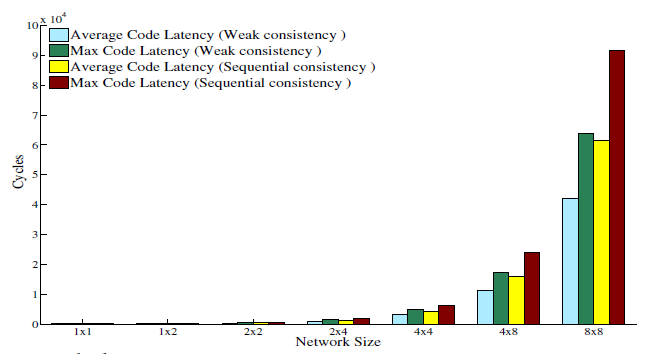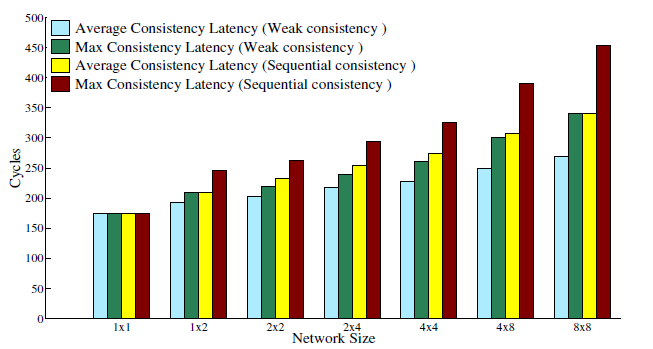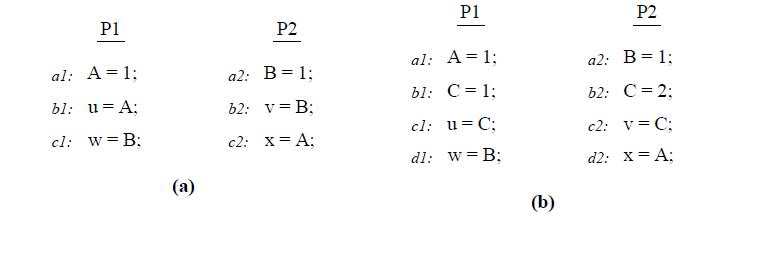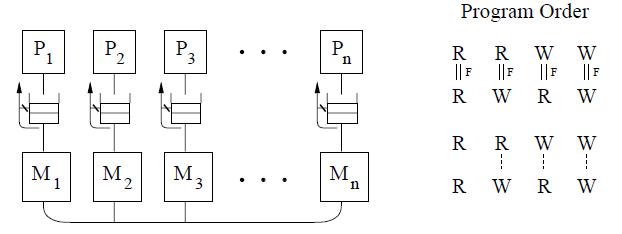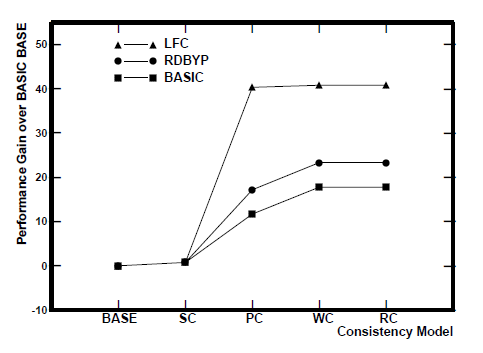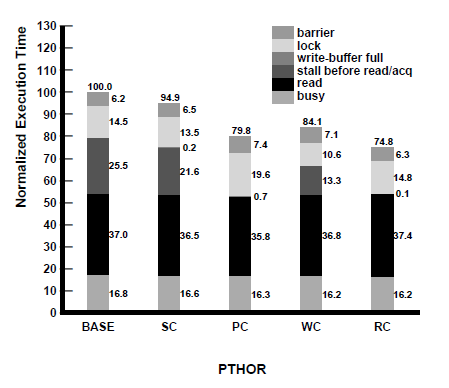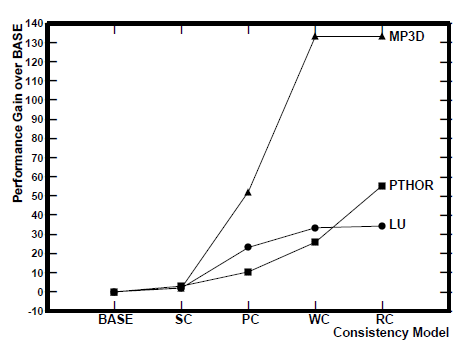CSC/ECE 506 Spring 2012/ch10 sj: Difference between revisions
| (7 intermediate revisions by the same user not shown) | |||
| Line 15: | Line 15: | ||
[[Image:SeqC.jpg]] <br /> | [[Image:SeqC.jpg]] <br /> | ||
The figure above shows the basic representation for sequential consistency. This conceptual system for SC consists of n processors sharing a single logical memory. Though the figure does not show caches, an SC implementation may still cache data as long as the memory system appears as a single copy memory(i.e the writes should appear atomic). As SC requires program order to be maintained among all operation types, the pictorial representation of the program order shows all combinations of reads and writes, the line between them telling that the operations are required to complete in program order. | The figure above shows the basic representation for sequential consistency. This conceptual system for SC consists of n processors sharing a single logical memory. Though the figure does not show caches, an SC implementation may still cache data as long as the memory system appears as a single copy memory(i.e the writes should appear atomic). As SC requires program order to be maintained among all operation types, the pictorial representation of the program order shows all combinations of reads and writes, the line between them telling that the operations are required to complete in program order. | ||
This model ensures that the reads of a variable, will return the new values written to it by a processor. Sequential consistency provides a simple, intuitive programming model. Because of its strict consistency requirements, sequential consistency, many of the architecture and compiler optimizations used in uniprocessors are not safely applicable to sequentially consistent multiprocessors.<ref>http://www.cesr.ncsu.edu/solihin/Main.html</ref> For this reason, many [http://en.wikipedia.org/wiki/Consistency_model Relaxed consistency models] have been proposed, most of which | This model ensures that the reads of a variable, will return the new values written to it by a processor. Sequential consistency provides a simple, intuitive programming model. Because of its strict consistency requirements, sequential consistency, many of the architecture and compiler optimizations used in uniprocessors are not safely applicable to sequentially consistent multiprocessors.<ref name="Solihin">http://www.cesr.ncsu.edu/solihin/Main.html</ref> For this reason, many [http://en.wikipedia.org/wiki/Consistency_model Relaxed consistency models] have been proposed, most of which | ||
are supported by commercial architectures. | are supported by commercial architectures. | ||
| Line 55: | Line 55: | ||
Protocols are complex and getting them right in hardware take substantial design time. A simple directory-based protocol can be developed under various assumptions, namely that the directory state and sharing vector are always aware of current cache state and that there is no overlap between requests. These assumptions, however, do not generally hold true in real systems, and various means have been devised to handle these types of situations. | Protocols are complex and getting them right in hardware take substantial design time. A simple directory-based protocol can be developed under various assumptions, namely that the directory state and sharing vector are always aware of current cache state and that there is no overlap between requests. These assumptions, however, do not generally hold true in real systems, and various means have been devised to handle these types of situations. | ||
The first situation can be handled by splitting up one of the states based on which node is believed to be the owner at the time. While the second situation can be handle by serializing requests, this tends to be very expensive from a performance standpoint. Additional complexity, therefore, must be built into the protocol design in order to allow for non-atomic request processing.<ref | The first situation can be handled by splitting up one of the states based on which node is believed to be the owner at the time. While the second situation can be handle by serializing requests, this tends to be very expensive from a performance standpoint. Additional complexity, therefore, must be built into the protocol design in order to allow for non-atomic request processing.<ref name="Solihin" /> | ||
All of the above schemes mentioned to improve performance of SC allow a processor to overlap or reorder its memory accesses without software support, however, either require complex or restricted hardware (e.g., hardware prefetching and rollback) or the gains are expected to be small. Further, the optimizations of these schemes can be exploited by hardware (or the runtime | All of the above schemes mentioned to improve performance of SC allow a processor to overlap or reorder its memory accesses without software support, however, either require complex or restricted hardware (e.g., hardware prefetching and rollback) or the gains are expected to be small. Further, the optimizations of these schemes can be exploited by hardware (or the runtime | ||
| Line 152: | Line 152: | ||
Let us consider an example to demonstrate the working of PSO.<br /> | Let us consider an example to demonstrate the working of PSO.<br /> | ||
[[Image:code2.jpg]]<br /> | [[Image:code2.jpg]]<br /> | ||
With relaxed Write to Read models, the only value for (u,v) is (1,1). With PSO, since it allows writes to different locations to complete out of program order, it also allows the outcomes (0,0) or (0,1) or (1,0) for (u,v). In this example, STBAR instruction needs to be placed immediately before ''c1'' on P1 in order to disallow all outcomes except (1,1).<ref | With relaxed Write to Read models, the only value for (u,v) is (1,1). With PSO, since it allows writes to different locations to complete out of program order, it also allows the outcomes (0,0) or (0,1) or (1,0) for (u,v). In this example, STBAR instruction needs to be placed immediately before ''c1'' on P1 in order to disallow all outcomes except (1,1).<ref name="Gharachorloo" /> | ||
==='''Relax Read to Read and Read to Write program orders'''=== | ==='''Relax Read to Read and Read to Write program orders'''=== | ||
| Line 304: | Line 304: | ||
===='''Lazy Release Consistency Model'''==== | ===='''Lazy Release Consistency Model'''==== | ||
Lazy release consistency (LRC) is consistency model most frequently used in Software Distributed Shared Memory. It is used for implementing release consistency that lazily pulls modifications across the interconnect only when necessary. The basic concept behind the protocol is to allow processors to continue referencing cache blocks that have been written by other processors. Although write notices are sent as soon as a processor writes a shared block, invalidations occur only at acquire operations. This is sufficient to ensure that true sharing dependencies are observed. Lazy algorithms such as LRC do not make modifications globally visible at the time of a release. Instead, LRC guarantees only that a processor that acquires a lock will see all modifications that precede the lock acquire.<ref>http://delivery.acm.org.www.lib.ncsu.edu:2048/10.1145/230000/224398/a61-kontothanassis.html?key1=224398&key2=6529911721&coll=ACM&dl=ACM&CFID=140829&CFTOKEN=60032635</ref><ref>http://infoscience.epfl.ch/record/55789/files/isca92.ps.pdf</ref> | Lazy release consistency (LRC) is consistency model most frequently used in Software Distributed Shared Memory. It is used for implementing release consistency that lazily pulls modifications across the interconnect only when necessary. The basic concept behind the protocol is to allow processors to continue referencing cache blocks that have been written by other processors. Although write notices are sent as soon as a processor writes a shared block, invalidations occur only at acquire operations. This is sufficient to ensure that true sharing dependencies are observed. Lazy algorithms such as LRC do not make modifications globally visible at the time of a release. Instead, LRC guarantees only that a processor that acquires a lock will see all modifications that precede the lock acquire.<ref name="Kontothanassis">http://delivery.acm.org.www.lib.ncsu.edu:2048/10.1145/230000/224398/a61-kontothanassis.html?key1=224398&key2=6529911721&coll=ACM&dl=ACM&CFID=140829&CFTOKEN=60032635</ref><ref name="Keleher">http://infoscience.epfl.ch/record/55789/files/isca92.ps.pdf</ref> | ||
<center> [[Image: LRC.jpg]] </center> | <center> [[Image: LRC.jpg]] </center> | ||
| Line 318: | Line 318: | ||
If an update policy is used in conjunction with Munin's write shared protocol and x is present in all caches, then all of these cached copies are updated at every release. Logically, however it suffices to update each processor's copy only when it acquires l. This results in a single message exchange per acquire as in a message passing implementation. | If an update policy is used in conjunction with Munin's write shared protocol and x is present in all caches, then all of these cached copies are updated at every release. Logically, however it suffices to update each processor's copy only when it acquires l. This results in a single message exchange per acquire as in a message passing implementation. | ||
Unlike eager algorithms such as Munin's write shared protocol, lazy algorithms such as LRC (Lazy Release Consistency) do not make modifications globally visible at the time of a release. Instead LRC guarantees only that a processor that acquires a lock will see all modifications that precede the lock acquire. As indicated in the above figure , all modifications that occur in program order before any of the releases in p1 through p4 precede the lock acquisition in p4. With LRC, modifications are propagated at the time of an acquire. Only the modifications that precede the acquire are sent to the acquiring processor. The modifications can be piggybacked on the message that grants the lock, further reducing message traffic. The following figure shows the message traffic in LRC for the same shared data accesses as in Figure under lazy consistency model section. l and x are sent in a single message at each acquire.<ref>http://www.cs.rochester.edu/research/cashmere/SC95/lazeag.html</ref><ref | Unlike eager algorithms such as Munin's write shared protocol, lazy algorithms such as LRC (Lazy Release Consistency) do not make modifications globally visible at the time of a release. Instead LRC guarantees only that a processor that acquires a lock will see all modifications that precede the lock acquire. As indicated in the above figure , all modifications that occur in program order before any of the releases in p1 through p4 precede the lock acquisition in p4. With LRC, modifications are propagated at the time of an acquire. Only the modifications that precede the acquire are sent to the acquiring processor. The modifications can be piggybacked on the message that grants the lock, further reducing message traffic. The following figure shows the message traffic in LRC for the same shared data accesses as in Figure under lazy consistency model section. l and x are sent in a single message at each acquire.<ref>http://www.cs.rochester.edu/research/cashmere/SC95/lazeag.html</ref><ref name="Keleher" /> | ||
<center> [[Image:lazy2.jpg]] </center> | <center> [[Image:lazy2.jpg]] </center> | ||
| Line 327: | Line 327: | ||
support for coherence should use protocols based on lazy release consistency, but in a less ''aggressively lazy'' form than is appropriate for DSM. | support for coherence should use protocols based on lazy release consistency, but in a less ''aggressively lazy'' form than is appropriate for DSM. | ||
These are the results they show from their experiments to compare Lazy and Eager Consistency Models:<ref | These are the results they show from their experiments to compare Lazy and Eager Consistency Models:<ref name="Kontothanassis" /> | ||
<br> | <br> | ||
<center>[[Image:Perf.jpg]]</center> | <center>[[Image:Perf.jpg]]</center> | ||
Latest revision as of 01:37, 14 April 2012
Memory Consistency models
Introduction
The memory consistency model of a shared-memory multiprocessor provides a formal specification of how the memory system will appear to the programmer, eliminating the gap between the behavior expected by the programmer and the actual behavior supported by a system. Effectively, the consistency model places restrictions on the values that can be returned by a read in a shared-memory program execution.
This material gives a brief explanation about the intuition behind using relaxed memory consistency models for scalable design of multiprocessors. It also explains about the consistency models in real multiprocessor systems like Digital Alpha, Sparc V9 , IBM Power PC and processors from Sun Microsystems.
Sequential Consistency Model (SC)
Introduction to Sequential Consistency Model
To write correct and efficient shared memory programs, programmers need a precise notion of shared memory semantics. To ensure correct execution, a programmer expects that the data value read should be the same as the latest value written to it in the system. However in many commercial shared memory systems,the processor may observe an older value, causing unexpected behavior. Intuitively, a read should return the value of the "last" write to the same memory location. In uniprocessors, "last" is precisely defined by the sequential order specified by the program called program order. This is not the case in multiprocessors. A write and read of a variable, are not related by program order because they reside on two different processors.
The uniprocessors model, however can be extented to apply to multiprocessors in a natural way. The resulting model is called Sequential consistency. In brief, sequential consistency requires that all memory operations
- appear to execute one at a time,
- all memory operations of a single processor appear to execute in the order described by that processor's program.
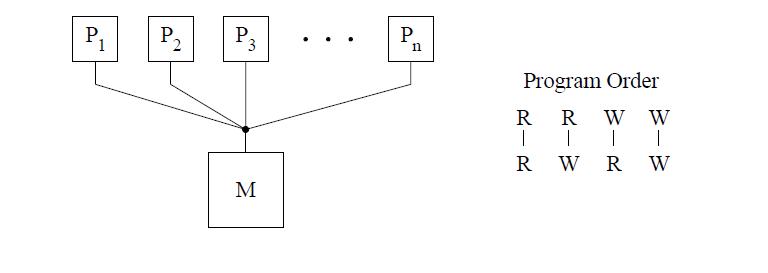
The figure above shows the basic representation for sequential consistency. This conceptual system for SC consists of n processors sharing a single logical memory. Though the figure does not show caches, an SC implementation may still cache data as long as the memory system appears as a single copy memory(i.e the writes should appear atomic). As SC requires program order to be maintained among all operation types, the pictorial representation of the program order shows all combinations of reads and writes, the line between them telling that the operations are required to complete in program order.
This model ensures that the reads of a variable, will return the new values written to it by a processor. Sequential consistency provides a simple, intuitive programming model. Because of its strict consistency requirements, sequential consistency, many of the architecture and compiler optimizations used in uniprocessors are not safely applicable to sequentially consistent multiprocessors.<ref name="Solihin">http://www.cesr.ncsu.edu/solihin/Main.html</ref> For this reason, many Relaxed consistency models have been proposed, most of which
are supported by commercial architectures.
Performance of Sequential Consistency on multiprocessors
Sequential Consistency (SC) is the most intuitive programming interface for shared memory multiprocessors. A system implementing SC appears to execute memory operations one at a time and in program order. A program written for an SC system requires and relies on a specified memory behavior to execute correctly. Implementing memory accesses according to the SC model constraints, however, would adversely impact performance because memory accesses in shared-memory multiprocessors often incur prohibitively long latencies (tens of times longer than in uniprocessor systems). To enforce sequential consistency, illegal reordering caused by hardware optimizations like Write buffers, Non-blocking caches etc and compiler optimizations like code motion, register allocation, eliminating common subexpressions, loop transformations etc resulting in reordering are not allowed. These are the optimizations which are implemented for better performance and are valid in uniprocessors. But in case of multiprocessors, these do not allow to satisfy the sequential consistency requirements and hence are not allowed. This affects the performance.
A number of techniques have been proposed to enable the use of certain optimizations by the hardware and compiler without violating sequential consistency, those having the potential to substantially boost performance. Some of them are mentioned below:
Hardware optimization techniques:
- Prefetching : A hardware optimization technique in which the processor automatically prefetches ownership for any write operations that are delayed due to the program order requirement (e.g., by issuing prefetch-exclusive requests for any writes delayed in the write buffer), thus partially overlapping the service of the delayed writes with the operations preceding them in program order. This technique is only applicable to cache-based systems that use an invalidation-based protocol. This technique is suitable for statically scheduled processors.
- Speculative Reads : A hardware optimization technique in which read operations that are delayed due to the program order requirement are serviced speculatively ahead of time. Sequential consistency is guaranteed by simply rolling back and reissuing the read and subsequent operations in the infrequent case that the read line gets invalidated or updated before the read could have been issued in a more straightforward implementation. This is suitable for dynamically scheduled processors since much of the roll back machinery is already present to deal with branch mispredictions. These two techniques of prefetching and speculative reads are expected to be supported by several next generation microprocessors like MIPS R10000 and Intel P6, thus enabling more efficient hardware implementations of sequential consistency.<ref>http://citeseerx.ist.psu.edu/viewdoc/download?doi=10.1.1.126.3128&rep=rep1&type=pdf</ref>
Software Optimization techniques
- Shasha and Snir's agorithm : A compiler algorithm proposed by Dennis Shasha and Marc Snir is used to detect when memory operations can be reordered without violating sequential consistency. It uses the technique where Sequential consistency can be enforced by delaying each access to shared memory until the previous access of the same processor has terminated. For performance reasons, it allows several accesses by the same processor to proceed concurrently. It performs an analysis to find a minimal set of delays that enforces sequential consistency. The analysis extends to inter-processor synchronization constraints and to code where blocks of operations have to execute atomically thus providing a new compiler optimization techniques for parallel languages that support shared variables.<ref>http://portal.acm.org/citation.cfm?id=42277</ref>
- Compiler algorithm for SPMD (Single Program multiple data) programs : The algorithm proposed by Sasha and Snir has exponential complexity. This new algorithm simplified the cycle detection analysis used in their algorithm to achieve the job in polynomial time.<ref>http://citeseerx.ist.psu.edu/viewdoc/download?doi=10.1.1.47.8185&rep=rep1&type=pdf</ref>
In general the performance of sequential consistency model on multiprocessors with shared memory is low. But with the use of above techniques, better performance can be achieved.
Limitations of cache-coherent directory-based systems
While cache-coherent directory-based systems offer a more scalable alternative than both snoopy bus protocols and snoopy point-to-point protocols, they are not without their limitations. These limitations can be overcome to some extent, but this results in trade-offs on both the hardware and the software level.
High waiting time at memory operations
Sequential consistency affects performance in scalable design. Because of this, a typical directory-based cache coherence protocol, such as a DASH, will use a relaxed consistency protocol in order to reduce the need to wait for operations to complete. DASH's release consistency model means that processor isn't locked up after a write operation begins. Still, there can be some bottle necks since synchronization must occur at implicit or explicit fences.
Addressing these potential stalls requires additional complexity in the way the protocol is implemented. For example, simple counters on each processor to ensure that invalidation operations have reached all processors could result in a processor using a dirty cache line with outstanding invalidates. Instead, the counter must be at the cache line level, and, in the case of DASH, invalidates must be enforced at the second-level cache.<ref>http://web.cecs.pdx.edu/~alaa/ece588/papers/lenoski_isca_1990.pdf</ref>
Limited capacity for replication
Communicated data is automatically replicated only in the processor cache, not in local memory. This can lead to capacity misses and artefactual communication when working sets are large and include non-local data or when conflict misses are numerous.
One way to address this is to increase cache size in order to reduce misses, but there are limitations to how large a cache can be. For example, a typical full-map directory coherence for a 16 multi-core processor with 64-byte blocks, 1MB L2 caches, and 64KB L1 caches would require over 288,000 directory entries. The directory size per core would then need to be 1.2MB to keep everything coherent, which would exceed the size of the L2 caches. While alternatives to full-map storage can be used, the use of these typically either increases both complexity and latency or reduces the ability to scale.
In addition, increasing cache size also increases access latency. Current caches are so large that having uniform access to the entire cache is no longer practical. Instead, the cache is broken up into slices, with the slices closest to the processor having the fastest access, while the ones further away requiring significantly more access time. This means that there are practical limits to how large a cache can be and still allow for a full-map directory.<ref>http://www.cs.cmu.edu/~hardav/papers/2009-ISCA-R-NUCA-Hardavellas.pdf</ref>
High design and implementation cost
Protocols are complex and getting them right in hardware take substantial design time. A simple directory-based protocol can be developed under various assumptions, namely that the directory state and sharing vector are always aware of current cache state and that there is no overlap between requests. These assumptions, however, do not generally hold true in real systems, and various means have been devised to handle these types of situations.
The first situation can be handled by splitting up one of the states based on which node is believed to be the owner at the time. While the second situation can be handle by serializing requests, this tends to be very expensive from a performance standpoint. Additional complexity, therefore, must be built into the protocol design in order to allow for non-atomic request processing.<ref name="Solihin" />
All of the above schemes mentioned to improve performance of SC allow a processor to overlap or reorder its memory accesses without software support, however, either require complex or restricted hardware (e.g., hardware prefetching and rollback) or the gains are expected to be small. Further, the optimizations of these schemes can be exploited by hardware (or the runtime system software), but cannot be exploited by compilers. Work related to compiler optimizations including that by Shasha and Snir motivate their work for hardware optimizations. Hardware costs are thus high to implement these techniques.
Hence researchers and vendors have alternatively relied on relaxed memory consistency models that embed the shared-address space programming interface with directives enabling software to inform hardware when memory ordering is necessary.
Performance Comparison
One experiment<ref>http://web.it.kth.se/~axel/papers/2011/ASPDAC-AbdulNaeem.pdf</ref> compared the Sequential Consistency model to the Weak Consistency model, using code latency and consistency latency as metrics.
This first diagram compares the average and maximum latencies of the two protocols. In this comparison, the average code latency in an 8x8 network for weak consistency is 241.96 times a single core, while the sequential consistency is 353.67. This gives a performance gain for weak consistency of 46.17% over sequential consistency.
The second diagram shows only consistency latency, which is the earlier code latency minus network and synchronization. The average for weak consistency on an 8x8 system is 1.54 times that of a single processor, while sequential consistency on 8x8 is 1.96 times a single core. This gives weak consistency a speedup of 33.76% over sequential consistency.
This example clearly illustrates the performance advantages of weaker consistency requirements over pure sequential consistency in some cases. By reducing the strength of the consistency model, more optimizations can be made and the overhead for the protocol can be reduced as well. However, this can also lead to more complex code as the programmer may need to think more carefully or add more synchronization code to make up for the reduced amount of certainty in execution order.
Relaxed Consistency Models
Uniprocessor optimizations such as write buffers and overlapped execution can violate sequential consistency. Therefore, general implementations of sequential consistency require a processor to execute its memory operations one at a time in program order, and writes are executed atomically. Many schemes discussed in the previous section do not require memory operations of a processor to be executed one at a time or atomically. However, these schemes either require restricting the network, or using complex hardware, or aggressive compiler technology. Even so, the performance gains possible are not known. For these reasons, there seems to be an emerging consensus in the industry to support relaxed memory models. Many commercially available architectures such as Digital Alpha, SPARC V8 and V9, and IBM PowerPC are based on this model. Relaxed memory consistency models allow the processors in the system to see different orderings between all or selected categories of memory operations that are strictly enforced in SC. Relaxed consistency models perform better than SC, but impose extra burden on the programmer to ensure that their programs conform to the consistency models that the hardware provides.
Different Relaxed consistency Models
The various relaxed models can be categorized based on how they relax the program order constraint:
- Write to Read relaxation: allow a write followed by a read to execute out of program order . Examples of models that provide this relaxation includes the IBM-370, Sun SPARC V8 Total Store Ordering (TSO), and Processor Consistency (PC) that we have seen in class.
- Write to Write relaxation: allows two writes to execute out of program order. The Sun SPARC V8 Partial Store Ordering (PSO) model relaxes two writes.
- Read to Read, Write: allows reads to execute out of program order with respect to their following reads and writes. The models that implement this relaxation include Digital Equipment Alpha (Alpha), Sun SPARC V9 Relaxed Memory Order (RMO), IBM PowerPC (PowerPC) and the weak ordering (WO) and release consistency (RC) models that we have seen in class.
Apart from the program order relaxation, some of these models also relax the write atomicity requirement.
4. Read others’ write early: allow a read to return the value of another processor’s write before the write is made visible to all other processors. This relaxation only applies to cache-based systems.
Let us consider the following example to illustrate this:
Let us see what happens if read returns new value before all copies see it. Below, (Write, A, 1) means the operation write on A returns 1 and (Read, A, 1) means the operation Read on A returns 1.
We see that in P3, Read A returns zero while it should have been 1. This is because A was read before the P1's write to A had propagated to P3.
5. Read own write early: a processor is allowed to read the value of its own previous write before the write is made visible to other processors.
This can happen if Flag1 is read early from write buffer, when read is re-ordered with respect to write.
All of the above models provide safety net that allow programmers to enforce the required constraints for achieving correctness. All models also maintain uniprocessor data and control dependences, and write serialization.<ref>http://www.cs.cornell.edu/Courses/cs717/2001fa/lectures/sarita.ppt</ref>
Let us now see the consistency models in some of the real multiprocessor systems listed above. We will not introduce those topics that are already covered in Solihin's textbook, like Weak ordering and Processor consistency models. RCsc and RCpc. RCsc maintains sequential consistency among synchronization operations, while RCpc maintains processor consistency among synchronization operations.
If program order is not guaranteed to be preserved by default, what mechanisms does the system provide for a programmer to enforce order explicitly when desired?
Relax Write to Read program order
Program order optimization is enabled by allowing a read to be reordered with respect to previous writes from the same processor and sequential consistency is maintained through the enforcement of the remaining program order constraints. Though relaxing the program order from a write followed by a read can improve performance, this reordering is not sufficient for compiler optimizations. The reason being most compiler optimizations require the full flexibility of reordering any two operations in program, and not just write to read. IBM-370, TSO, and PC models relax Write to Read program order. The models to be discussed under this type of relaxation differ in when they allow a read to return the value of a write.
IBM-370
The IBM-370 model relaxes certain writes to reads program order but maintains the atomicity requirements of SC. This model enforces the program order constraint from a write to a following read, by using the safety net serialization instructions that may be placed between the two operations. This model is the most stringent, only next to SC because the program order from a write to a read still needs to be maintained in the below three cases:
- A write followed by a read to the same location [depicted by dashed line in between W and R in the figure].
- If either write or read are generated by a serialization instruction[ WS , RS].
- If there is a non-memory serialization instruction such as fence instruction[F] between the write and read.
The conceptual system shown in the above figure is similar to that used for representing SC. The main difference is the presence of a buffer between each processor and the memory. Since we assume that each processor issues its operations in program order, we use the buffer to model the fact that the operations are not necessarily issued in the same order to memory. The cancelled reply path from the buffer to the processor implies that a read is not allowed to return the value of a writeto the same location from the buffer.
The IBM-370 model has two types of serialization instructions: special instructions that generate memory operations (e.g., compare-and-swap) and special non-memory instructions (e.g., a special branch)<ref name="Gharachorloo">http://infolab.stanford.edu/pub/cstr/reports/csl/tr/95/685/CSL-TR-95-685.pdf</ref>
SPARC V8 Total Store Ordering (TSO)
The total store ordering (TSO) model is one of the models proposed for the SPARC V8 architecture. TSO always allows a write followed by a read to complete out of program order, i.e reads issued to the same pending writes are allowed to be reordered. Read returns a previous write value if present, else fetches the value from the memory. All other program orders are maintained. This is shown in the conceptual system below by the reply path from the buffer to a read that is no longer blocked.
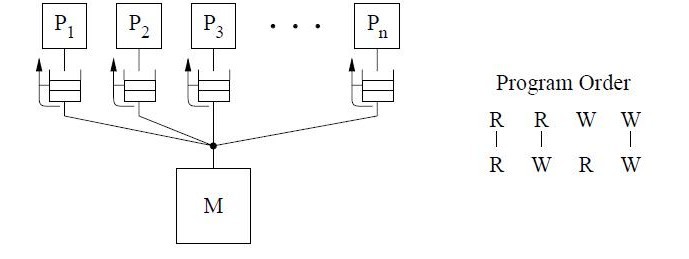
For TSO, a safety net for write atomicity is required only for a write that is followed by a read to the same location in the same processor. The atomicity can be achieved by ensuring program order from the write to the read using read-modify-writes.
Difference between IBM370 and TSO:
Let us consider the program segment below to demonstrate the difference between TSO and IBM 370 models:
First consider the program segment in (a). Under the SC or IBM-370 model, the outcome (u,v,w,x)=(1,1,0,0) is disallowed. However, this outcome is possible under TSO because reads are allowed to bypass all previous writes, even if they are to the same location; therefore the sequence (b1,b2,c1,c2,a1,a2) is a valid total order for TSO. Of course, consistency value requirement still requires b1 and b2 to return the values of a1 and a2, respectively, even though the reads occur earlier in the sequence than the writes. This maintains the intuition that a read observes all the writes issued from the same processor as the read. Consider the program segment in (b). In this case, the outcome (u,v,w,x)=(1,2,0,0)is not allowed under SC or IBM-370, but is possible under TSO.<ref name="Gharachorloo" />
Relax Write to Write program order
This category of relaxed models allows
- Two writes to execute out of program order.
- A write followed by a read execute out of program order.
This relaxation enables a number of hardware optimizations, including write merging in a write buffer and overlapping multiple write misses, thus servicing, the writes at a much faster rate. But this relaxation is not sufficiently flexible to be useful to a compiler. The SPARC V8 Partial Store Ordering model (PSO) is an example of such a model that we describe below.
SPARC V8 Partial Store Ordering
The Partial Store Ordering(PSO) model is similar to the TSO model for SPARC V8. The figure below shows an identical conceptual system. There is only a slight difference in the program order, where writes to locations can be overlapped only if they are not to same locations. This is represented by the dashed line between the W's in the program order figure. Safety net for the program order is provided through a fence instruction, called the store barrier or STBAR, that may be used to enforce the program order between writes.
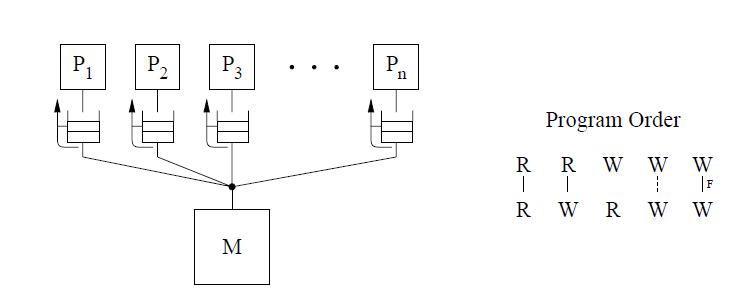
Let us consider an example to demonstrate the working of PSO.

With relaxed Write to Read models, the only value for (u,v) is (1,1). With PSO, since it allows writes to different locations to complete out of program order, it also allows the outcomes (0,0) or (0,1) or (1,0) for (u,v). In this example, STBAR instruction needs to be placed immediately before c1 on P1 in order to disallow all outcomes except (1,1).<ref name="Gharachorloo" />
Relax Read to Read and Read to Write program orders
This model sheds the restriction on program order between all operations, including read to read and read followed by write to different locations . This flexibility provides the possibility of hiding the latency of read operations by implementing true non-blocking reads in the context of either static (in-order) or dynamic (out-of-order) scheduling processors, supported by techniques such as non-blocking (lockup-free) caches and speculative execution. The compiler also has full flexibility to reorder operations.
Weak ordering (WO), Release consistency (RC), DEC Alpha, Relaxed Memory Order (RMO), and PowerPC are examples of this model, with the last three models for commercial architectures. Except for Alpha,all the other models allow reordering of two reads to the same location.
All of the models in this group allow a processor to read its own write early with the exception of RCpc, a flavor of Release consistency (RC) and PowerPC. All the three commercial architectures provide explicit fence instructions to ensure program order. Frequent use of fence instructions can incur a significant overhead due to an increase in the number of instructions and the extra delay that may be associated with executing fence instructions.
DEC Alpha
The program order constraints allow reads and writes to different locations to complete out of program order
unless there is a fence instruction between them. Memory operations to the same location, including reads, are required to complete in program order. Safety net for program order is provided through the fence instructions, the memory barrier (MB) and the write memory barrier (WMB). The MB instruction can be used to maintain program order between any memory operations, while WMB instruction provides this guarantee only among write operations. The Alpha model does not require a safety net for write atomicity.
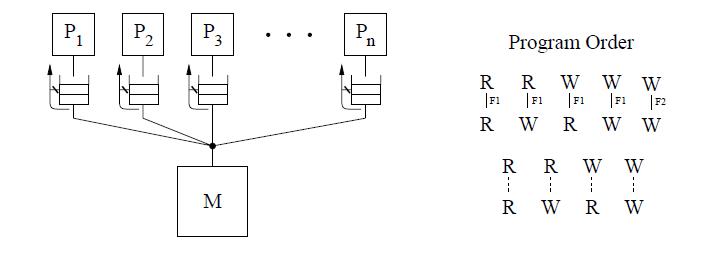
The conceptual system shown above is the same same as IBM 370 which requires a read to return the value of the last write operation to the same location. But since we can relax the program order from a write to a read, we can safely exploit optimizations such as read forwarding.
Relaxed Memory Order (RMO)
The SPARC V9 architecture uses RMO which is an extension of the TSO and PSO models used in SPARC V8.
The Read to Read, Read to write program order is relaxed in this model, like in PSO. But a Read to Write or the order between two writes to the same location are not relaxed. This is shown in the figure for program order below.

RMO provides four types of fences[F1 through F4] that allow program order to be selectively maintained between any two types of operations. A single fence instruction, MEMBAR, can specify a combination of the above fence types by setting the appropriate bits in a four-bit opcode. No safety net for write atomicity is required.
IBM PowerPC
This model constrains the program order
-Between sub-operations. That is each operation may consist of multiple sub-operations and that all sub-operations of the first operation must complete before any sub-operations of the second operation.[represented by the double lines between operations in the figure below].
-Writes to the same location.
-Among conflicting operations.
The IBM PowerPC model exposes multiple-copy semantics of memory to the programmer as shown in the conceptual system above. Safety net fence instruction is called SYNC which is similar to the MB fence instruction of the Alpha systems. However, SYNC between two reads allows to occur out of program order. Also PowerPC allows a write to be seen early by another processor’s read. Hence a read-modify-write operation may be needed to enforce program order between two reads to the same location as well as to make writes appear atomic.
The table below summarizes the program constraint under each model we have described so far.
| Relaxation | W-> R order | W -> W order | R -> RW order | Read Others Write Early Order | Read Own Write Early Order | Safety net |
| SC | Yes | |||||
| IBM 370 | Yes | serialization instructions | ||||
| Total Store Ordering | Yes | Yes | RMW | |||
| PC | Yes | Yes | Yes | RMW | ||
| PSO | Yes | Yes | Yes | RMW, STBAR | ||
| WO | Yes | Yes | Yes | Yes | synchronization | |
| RCsc | Yes | Yes | Yes | Yes | release, acquire, nsync, RMW | |
| RCpc | Yes | Yes | Yes | Yes | Yes | release, acquire, nsync, RMW |
| Alpha | Yes | Yes | Yes | Yes | MB, WMB | |
| RMO | Yes | Yes | Yes | Yes | MEMBARs | |
| PowerPC | Yes | Yes | Yes | Yes | Yes | Sync |
RMW : read-modify-write instruction
nsyncs : asynchronous data operations or special operations that are not used for synchronization.
More information on Release Consistency models is presented in the next section.
The table below shows some of the other commercial systems that relax sequential consistency.

Release Consistency Related Models
Release consistency provides these two kinds. Acquire accesses are used to tell the memory system that a critical region is about to be entered. Release accesses say that a critical region has just been exited. These accesses can be implemented either as ordinary operations on special variables or as special operations.
Release Consistency Models
Eager Release Consistency Model
In Eager Release Consistency Model , the invalidations (or write notices) are propagated at release points. Munin's write shared protocol proposed by John K. Bennett, John B. Carter, and WiUy Zwaenepoel of Rice University implemented this Eager Release Consistency Model. It is a software implementation of Release consistency Model which buffers writes until a release, instead of pipelining them as in the DASH implementation. At the release all writes going to the same destination are merged into a single message. This is illustrated in the following diagram:

This approach is conservative because the system does not know when the next acquire by another processor will occur or whether a given process will even perform an acquire and need to see those write notices.<ref>http://infoscience.epfl.ch/record/55790/files/sosp91.ps.pdf</ref><ref>http://www.springerlink.com/content/mg141q86k2112788/fulltext.pdf?page=1</ref>
Lazy Release Consistency Model
Lazy release consistency (LRC) is consistency model most frequently used in Software Distributed Shared Memory. It is used for implementing release consistency that lazily pulls modifications across the interconnect only when necessary. The basic concept behind the protocol is to allow processors to continue referencing cache blocks that have been written by other processors. Although write notices are sent as soon as a processor writes a shared block, invalidations occur only at acquire operations. This is sufficient to ensure that true sharing dependencies are observed. Lazy algorithms such as LRC do not make modifications globally visible at the time of a release. Instead, LRC guarantees only that a processor that acquires a lock will see all modifications that precede the lock acquire.<ref name="Kontothanassis">http://delivery.acm.org.www.lib.ncsu.edu:2048/10.1145/230000/224398/a61-kontothanassis.html?key1=224398&key2=6529911721&coll=ACM&dl=ACM&CFID=140829&CFTOKEN=60032635</ref><ref name="Keleher">http://infoscience.epfl.ch/record/55789/files/isca92.ps.pdf</ref>

Comparison between Lazy and Eager Release Consistency Models
Eager release consistency represents the state of the art in release consistent protocols for hardware-coherent multiprocessors, while lazy release consistency has been shown to provide better performance for software distributed shared memory (DSM). Several of the optimizations performed by lazy protocols have the potential to improve the performance of hardware-coherent multiprocessors as well, but their complexity has precluded a hardware implementation.
An Eager Release Consistency Model like Munin's write shared protocol may send more messages than a message passing implementation of the same application. The following figure shows an example where processors p1 through p4 repeatedly acquire the lock l, write the shared variable x, and then release l.
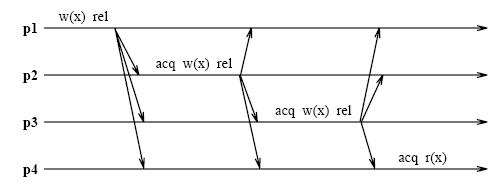
If an update policy is used in conjunction with Munin's write shared protocol and x is present in all caches, then all of these cached copies are updated at every release. Logically, however it suffices to update each processor's copy only when it acquires l. This results in a single message exchange per acquire as in a message passing implementation.
Unlike eager algorithms such as Munin's write shared protocol, lazy algorithms such as LRC (Lazy Release Consistency) do not make modifications globally visible at the time of a release. Instead LRC guarantees only that a processor that acquires a lock will see all modifications that precede the lock acquire. As indicated in the above figure , all modifications that occur in program order before any of the releases in p1 through p4 precede the lock acquisition in p4. With LRC, modifications are propagated at the time of an acquire. Only the modifications that precede the acquire are sent to the acquiring processor. The modifications can be piggybacked on the message that grants the lock, further reducing message traffic. The following figure shows the message traffic in LRC for the same shared data accesses as in Figure under lazy consistency model section. l and x are sent in a single message at each acquire.<ref>http://www.cs.rochester.edu/research/cashmere/SC95/lazeag.html</ref><ref name="Keleher" />
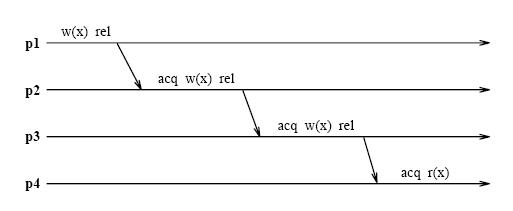
Performance Analysis of Lazy and Eager Consistency Models
Leonidas I. Kontothanassis, Michael L. Scott, and Ricardo Bianchini from University of Rochester have performed experiments to evaluate a lazy release-consistent protocol suitable for machines with dedicated protocol processors. Their results indicate that the first protocol outperforms eager release consistency by as much as 20% across a variety of applications. The lazier protocol, on the other hand, is unable to recoup its high synchronization overhead. This represents a qualitative shift from the DSM world, where lazier protocols always yield performance improvements. Based on their results, they conclude that machines with flexible hardware support for coherence should use protocols based on lazy release consistency, but in a less aggressively lazy form than is appropriate for DSM.
These are the results they show from their experiments to compare Lazy and Eager Consistency Models:<ref name="Kontothanassis" />
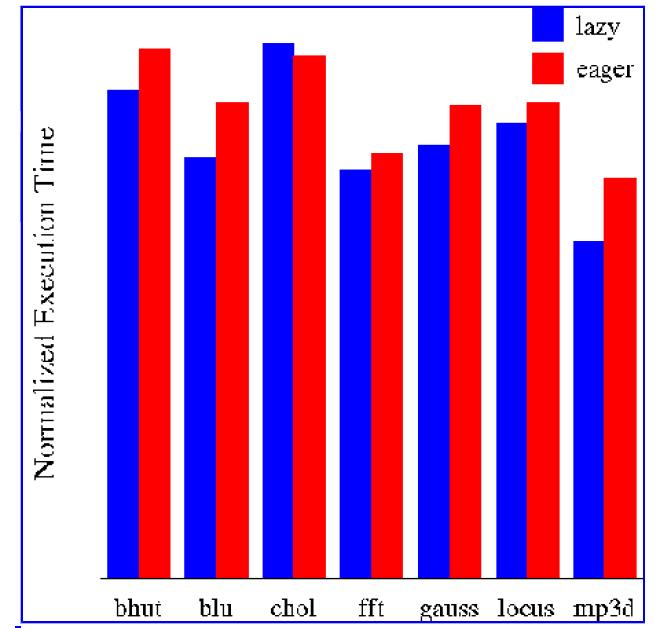
Other Release Consistency Related Models
Entry Consistency Model
Like the two variants of release consistency, entry consistency model too requires the programmer to use acquire and release at the start and end of each critical section, respectively. However, unlike release consistency, entry consistency requires each ordinary shared variable to be associated with some synchronization variable such as a lock or barrier. If it is desired that elements of an array be accessed independently in parallel, then different array elements must be associated with different locks. When an acquire is done on a synchronization variable, only those ordinary shared variables guarded by that synchronization variable are made consistent. Formally, a memory exhibits entry consistency if it meets all the following conditions :
- An acquire access of a synchronization variable is not allowed to perform with respect to a process until all updates to the guarded shared data have been performed with respect to that process.
- Before an exclusive mode access to a synchronization variable by a process is allowed to perform with respect to that process, no other process may hold the synchronization variable, not even in nonexclusive mode.
- After an exclusive mode access to a synchronization variable has been performed, any other process next nonexclusive mode access to that synchronization variable may not be performed until it has performed with respect to that variable's owner.
Entry consistency differs from lazy release consistency in that the latter does not associate shared variables with locks or barriers and at acquire time has to determine empirically which variables it needs.
Delayed consistency Model
In a cache-based system, a store may cause an invalidation (write-invalidate protocol) or updates to other caches (writebroadcast protocol). In present systems, when a such coherence update must be sent, the cache controller is blocked while the update signals propagate and are acknowledged. If these update signals are buffered so that the cache is not blocked during the propagation of the signals, we say that coherence is send delayed. This buffering is different from the usual Store buffer needed in systems with write-through caches. Coherence can also be receive delayed. Namely, if a coherence update signal reaches a cache, the effect of the update can be temporarily buffered. By delaying the sending of updates, update propagation can be overlapped with cache activity. The figure below shows the system structure with store buffers and coherence update buffers used for delayed consistency models.
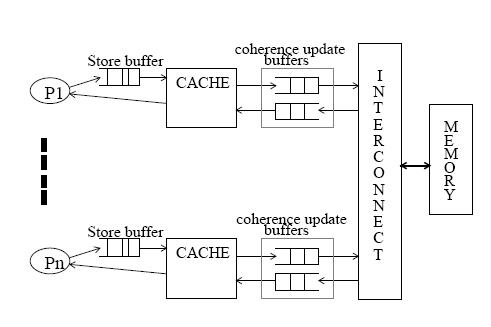
In a system with delayed consistency, synchronization variables must be stored in different regions of shared memory than other shared data. Accesses to the region of memory reserved for synchronization variables are not subject to delays, so that an On-the-Fly protocol is enforced on these variables. Therefore, the processor must have the ability to distinguish between synchronization variables and other variables. The state transition diagram for the On-the fly protocol is as shown below :

The different states are (a) Cache states and (b) System Directory states.
- Cache States : If a cache block is Valid, then the cache may be an Owner (i.e. the copy is unique in the system and it is dirty) or a Keeper (i.e. there may be copies in other caches and all copies are clean).
- System Directory states : There is one Modified bit and P Presence bits (one per processor) per block in memory. A Presence bit is set only if the corresponding cache is an Owner or a Keeper of the block. If a cache is the Owner of the block (in which case
only one P bit is set), then the Modified bit is also set.
The commands issued by cache controller are :
- ReqO (Request Ownership): the memory controller sends an Inv command to all caches with a copy and the requesting cache becomes the Owner.
- ReqOC (Request Owner Copy): same as ReqO, but the memory copy of the block is also sent to the requesting cache.
- ReqKC (Request Keeper Copy): if there is an Owner, the memory controller sends an UpdM command to the Owner. The memory copy of the block is then sent to the requesting cache (which becomes a Keeper).
- WB (Write Back): the block is written back to memory.
Thus delayed consistency models allow the overlapping of cache activity and sending of invalidations. Delayed consistency also reduces the number of false sharing transitions. The only restriction is that parallel programs must access shared writable data in critical or semi-critical sections.<ref>http://www.barroso.org/publications/delayed.pdf</ref>
Performance of Consistency Models
The advantage of the less strict models is increased performance potential. The disadvantage is increased hardware complexity and a more complex programming model. To make an informed decision on the above tradeoff requires performance data for the various models. There were many experiments conducted to examine systems with non-bus interconnection networks and that use real programs as workloads.
Kourosh Gharachorloo et al. at Stanford University compared the models of sequential consistency, processor consistency, weak ordering, and release consistency for a DASH-like architecture. The results show that in an environment where processor reads are blocking and writes are buffered, a significant performance increase is achieved from allowing reads to bypass previous writes. Pipelining of writes, which determines the rate at which writes are retired from the write buffer, is of secondary importance. As a result, they have showed that the sequential consistency model performs poorly relative to all other models, while the processor consistency model provides most of the benefits of the weak and release consistency models. It showed that the relaxed models can hide most of the write latency and can perform upto 41% better than sequential consistency. It also showed that with blocking reads, processor consistency performed as well as weak ordering and release consistency for most cases. This result is surprising because processor consistency only allows reads to bypass writes, whereas weak ordering and release consistency also allow writes to be pipelined. Thus, potentially with processor consistency, the write buffer could get full faster and the processor could have to block often on writes. However, with blocking reads, much of the latency of writes is hidden behind the reads, and the write buffer does not block often. In one case, processor consistency even does better than weak ordering because weak ordering requires its synchronization reads to stall for previous write operations, whereas in processor consistency, reads are never stalled for previous writes.<ref>http://ra.ziti.uni-heidelberg.de/pages/lectures/hws06/ra2/script_pdf/dash.pdf </ref><ref>http://citeseerx.ist.psu.edu/viewdoc/download?doi=10.1.1.52.9935&rep=rep1&type=pdf</ref>
Here are some figures from their experiment:
This figure shows the relative performance gain for the MP3D application under three different implementations of the caches. This clearly indicates that weak consistency and relaxed consistency perform dramatically better than the other consistency models under all three implementations, though they tie with each other.
This figure shows the broken down normalized execution time of the PTHOR application using the four consistency models. In this case, processor consistency slightly outperforms weak consistency, but relaxed consistency still does the best.
This final diagram shows the effects of ideal prefetching on three different applications using all four consistency models. Yet again, WC and RC beat all the rest by a fairly significant margin, tying twice and RC performing the best with the PTHOR application.
Ronald Bos et al. investigated the performance benefits of relaxed consistency models on multiprocessors executing a process network application. They used a trace-driven simulator, developed using SystemC, to model the distributed shared memory system of a prototype multiprocessor developed at Philips called Philips CAKE (a nonuniform, distributed shared memory multiprocessor prototype). The simulator offers two consistency models: Sequential Consistency (SC) and a generalized Relaxed Consistency (RC) model. Input traces were generated by running a process network application in a cycle-accurate simulator of the prototype multiprocessor. The results showed that relaxed consistency has marginal performance benefits over sequential consistency. The advantage of relaxed memory consistency decreases for increasing network latency.<ref>http://ce.et.tudelft.nl/publicationfiles/915_463_bos.pdf</ref>
Most of the above studies evaluate runtime optimizations. These clearly show that there have not been any studies evaluating performance gains for the relaxed models due to compiler optimizations. Many researchers argue that the performance boost from implementing models in the class relaxing all orders is enough to justify the additional intellectual burden the relaxed models place on the middleware authors of complex commercial systems. The performance gained by using relaxed models does not justify their complexity.<ref>http://www.cs.wisc.edu/multifacet/papers/computer98_sccase.pdf</ref>
References
<references />
